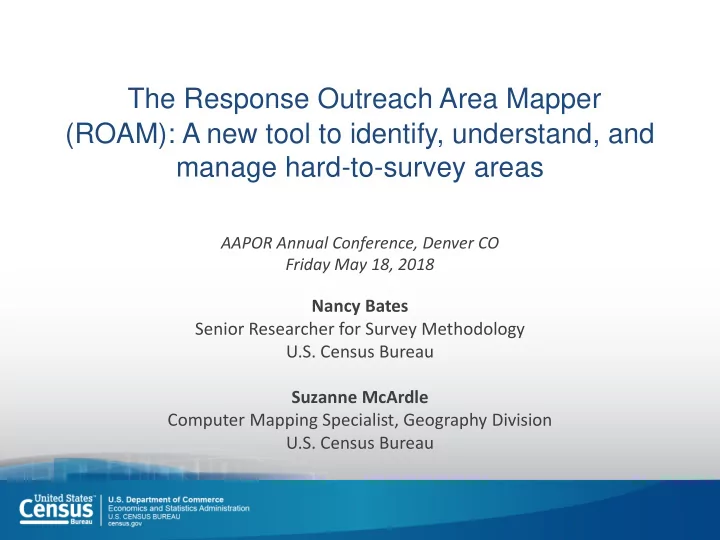

The Response Outreach Area Mapper (ROAM): A new tool to identify, understand, and manage hard-to-survey areas AAPOR Annual Conference, Denver CO Friday May 18, 2018 Nancy Bates Senior Researcher for Survey Methodology U.S. Census Bureau Suzanne McArdle Computer Mapping Specialist, Geography Division U.S. Census Bureau
2
Introduction In 1990s Census Bureau developed a Hard to Count Score (HTC) Households in each census tract assigned a score The higher the score, the harder to count Field Division used the score to make hiring decisions and resource allocations Partnership Specialists used the score in 2000 and 2010 Censuses to identify areas requiring extra effort For 2020 Census a new hard-to-survey metric has been developed: the Low Response Score (LRS) 3
For methodology of LRS see… Erdman, C. and N. Bates (2017). The Low Response Score (LRS): “A Metric to Locate, Predict, and Manage Hard-to-Survey Populations”, Public Opinion Quarterly , Volume 81, Issue 1, 1 March 2017, pp. 144 – 156.
Low Response Score LRS = predicted level of Census self non- response at the tract level Values from 0-100 So, for example, if LRS=25, we are estimating that 25% of households in that tract will not self-respond to the Census LRS is updated yearly using new 5-year ACS 5
Low Response OLS Linear Model 6 / 20
Distribution of the LRS 25000 20000 Number of Block Groups 15000 10000 Rule of thumb… areas with LRS = >30 are hardest to count? 5000 0 0 10 40 50 20 30 Low Response Score 7 Source: Erdman and Bates, 2017
However, think locally… What constitutes a “high” LRS depends Are you concerned with a particular State, Census Region, Place, or County? If yes, extract tracts within that geographic area and produce custom LRS distribution What score is cutoff for top decile? Quintile? Identify tracts matching your cutoff 8
How do I access the LRS? We have built a Web browser-based LRS application Branded as: Response Outreach Area Mapper (ROAM) www.census.gov/roam Public interface to map and display characteristics of hard-to-survey areas from the PDB ROAM displays census tracts indicating hard-to-survey areas (darker color = higher LRS = harder-to-count) ROAM also displays selected variables describing the census tracts Allows users to set customized parameters and pull extracts 10
11
LRS limitations/cautions Only considers mail self-response – 2020 Census will offer internet, phone AND mail Some tracts have small Ns in mailback universe, e.g. Indian reservations, very rural areas If LRS is extremely high, take a closer look 12
That said….LRS does pretty well predicting ACS self-response (tract level) R 2 for propensity models 2010 Census ACS 2013-2016* Independent variables mail return rate self-response rate n=71,657 n=71,454 Low Response Score (LRS) 0.59 0.64 *Internet and mail responses combined 13
Nancy Bates Senior Researcher for Survey Methodology nancy.a.bates@census.gov (301) 763-5248
ROAM Demonstration www.census.gov/roam 15
Recommend
More recommend